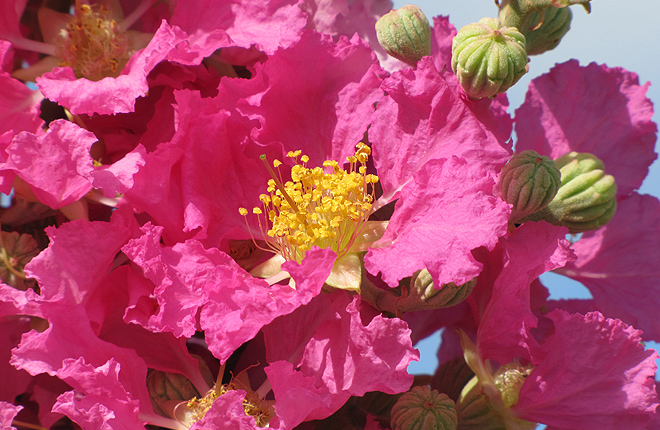Crape Myrtle for South Florida
A striking type of pink crape myrtle could soon be gracing lawns and gardens in southern Florida because of a chance discovery by Agricultural Research Service scientists.
Commonly called Pride-of-India or queen’s crape myrtle, Lagerstroemia speciosa is a species of crape myrtle native to India and Southeast Asia that has been cultivated as an ornamental in tropical areas worldwide. Dozens of commercial crape myrtle varieties exist, but those of L. speciosa may have the largest, brightest, and most striking flowers of any of them, says Alan W. Meerow, a geneticist at the ARS Subtropical Horticulture Research Station (SHRS) in Miami.
Meerow calls the new release Big Pink and says it will grow to up to 19 feet in 5 years and flower from March through the end of summer—and often into fall. As with other queen’s crape myrtles, it is not as cold hardy as the crape myrtle varieties that are found as far north as Pennsylvania. Its range is limited to southern Florida, but “people who see it are struck by it,” Meerow says.
Big Pink has been cultivated by Meerow and his colleagues since 2005, when they came upon a street planting of queen’s crape myrtle trees with pink, purple, light-lavender, and near-white flowers on an avenue near the ARS facilities in Mayagüez, Puerto Rico. Meerow was familiar with the species; some were growing at SHRS in Miami and are now 85 years old and about 50 feet tall. (In the wild, L. speciosa trees can be over 60 feet tall.)
Meerow and his colleagues were struck by the color variety of the Mayagüez trees. They collected seeds from each tree and started growing them outdoors at SHRS, ultimately selecting six seedlings. Of those six, one of the two pink-flowered trees stood out because its blooms were larger, more brightly colored, and “showier” than any crape myrtle blooms they had ever seen.
The scientists took cuttings and established them in 8-inch containers of nursery soil. After a few months, they planted them in the ground at different locations around SHRS and in varying soil types to evaluate them for susceptibility to pests and diseases. They also replanted cuttings from those plants in 2005, 2007, and 2009. Over 10 years, they found no problems with pests or diseases. The plants in Miami are nearly 20 feet tall after 7 years in the ground.
A paper describing the discovery was published in HortScience in October 2015, and Big Pink will soon join dozens of crape myrtle varieties being sold in southern Florida’s nurseries and garden centers. Cuttings are available for research purposes, and once Meerow propagates more, he will make the plant available to nurseries. Rooted cuttings initially can be placed in 4-inch containers for a month or two and then transferred to 8-inch containers, where the plants will flower. Plants can usually be sold just 6 to 8 months after rooted cuttings are initially potted.—By Dennis O’Brien, Agricultural Research Service Information Staff.
“Crape Myrtle for South Florida” was published in the February 2016 issue of AgResearch Magazine.
Key Facts
- New crape myrtle release has large, showy, pink blooms.
- Trees can grow to a height of 19 feet in 5 years.
- U.S. range is limited to southern Florida and Puerto Rico.
Full Story







